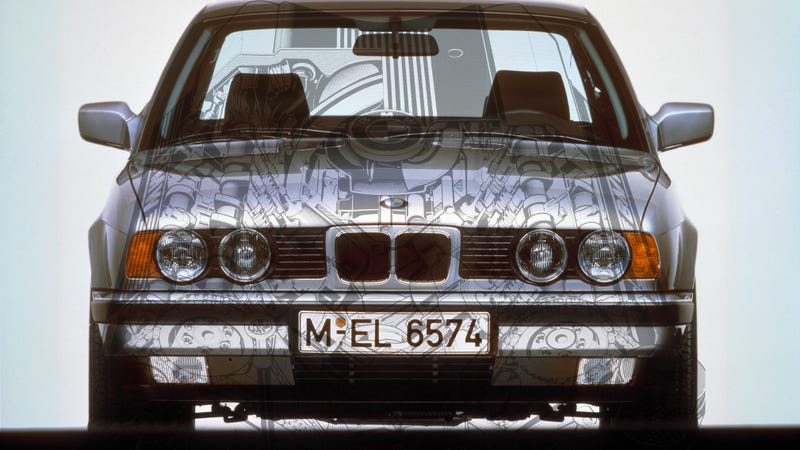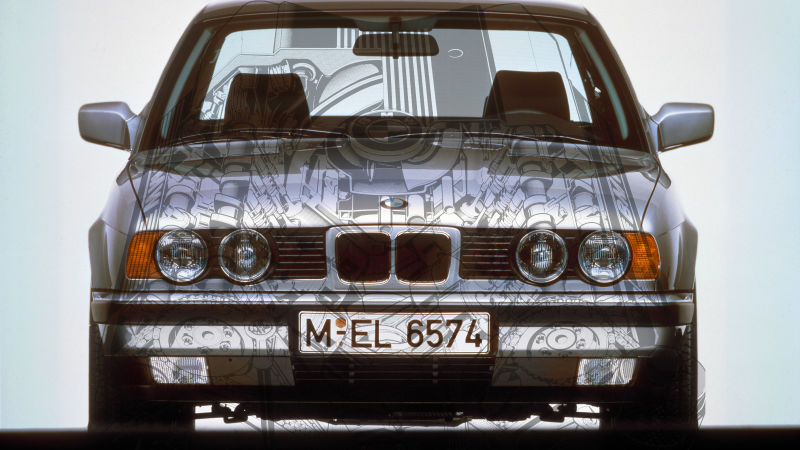
BMW is a V8-heavy company today, with twin-turbo versions filling up just about every big-power model it has on sale. It’s hard to even remember when they were completely alien to the Bavarians, and how it broke back into the world of eights with a compact 3.0-liter, flawed from the start.
Maybe you could say that it wasn’t flawed, but to be fair, it wasn’t built for the imperfect world around it. And no world was more imperfect than America and our bad gas. But I’m getting ahead of myself.
Advertisement
This is the BMW M60 engine, specifically the M60 B30, the latter half of that code referring to its 3.0-liter displacement. It debuted in the early 1990s and was used in the BMW E34 5 Series (called the 530i) and the contemporary E38 7er (called the 730i). Here’s the E34 because it is gorgeous:
Advertisement
I’m going to post another photo of the wagon just because I am currently imagining my fnatasy life where I am a V8 E34 Touring driver who uses it to tow things like my Piaggio Ape race truck and my buddy’s boat:
Alright, enough of that. Looking at the engine’s displacement, one so associated with big straight sixes, attached to a little V8 almost reads wrong to anyone’s eyes today, as it did when friend of Jalopnik Kevin McCauley tweeted it out the other day:
Advertisement
But again, there’s a reason why this engine has been almost left out of history.
First of all, there’s little need to remember it.
Advertisement
BMW made a 4.0-liter version of the engine, the M60 B40, which would be the go-to choice if you were doing an engine swap from this generation. But you wouldn’t even need to swap from this generation of V8s at all, because it wasn’t many years before BMW replaced the M60 with the M62. That was basically the same engine but made out of better material and with more power and displacement.
And there’s no real need to even lionize the engine as some pinnacle of greatness because the M62 served as a jumping off point to the most legendary BMW V8 of all, the S62 from the E39 M5. With individual throttle bodies and BMW’s first use of VANOS variable valve timing, it made nearly 400 horsepower from 4.9 liters, naturally aspirated from the end of the 1990s.
Advertisement
By contrast, the M60 B30, debuting at the start of the decade, put out a fair 215 HP from its 3.0 liters, along with just 214 lb-ft of torque. Though it was a quad-cam engine (using a set of huge timing chains rather than belts), with 32 valves, it was oriented more towards luxury than raw performance. CAR Magazine called the E34 530i “mellow,” when it drove the car against the original Audi S4 Avant and a contemporary Mercedes W124 wagon back in 1993. The M60 B30 was a “soft, waffly” V8, that was powerful but serene. It didn’t give up much performance to, say, the 220 HP turbo five in the Audi, but that was a wild kind of engine and the V8 just wasn’t.
Again, this was a cutting edge engine of the time, but it was quickly overshadowed and overshadowed once more.
Advertisement
More important to today’s enthusiasts, M60s aren’t the easiest things to tune, as this lengthy report details, noting that any big power gains cost just about as much as simply buying a nicer, later BMW V8 from the get go. Any time someone goes on a forum to wonder if they can stick M5 ITBs on their old 7 Series, everyone else piles on them noting that the swap is far from straightforward. What you can work on are building yourself 4-into-1 headers as the ones BMW used were crimped for space. Big cams and doing work on your valves are also ways to make gains, but that’s not something I’d be leaping to do myself.
But that’s not what has made the M60 so easily forgotten. That has to do with a treatment called Nikasil, detailed by US Auto Parts in a now-archived consumer report:
The Nikasil coating process was developed by the German firm Mahle, originally for use in the Mercedes Wankel rotary. Audi, BMW, Ferrari and Jaguar have all used Nikasil engines in their production cars. Porsche used Nikasil in their turbocharged 917 – 935 series of race cars. In racing two strokes, both Morbidelli and Rotax have had great success with Nikasil. Nikasil has been used in thousands of professional grade chainsaws, motorcycle and marine engines, and even many NASCAR Winston Cup and Formula One engines.
Nikasil has been used in high performance engines because it allows the total elimination of poor-cooling cast-iron, and it is harder and more oleophilic (oil-liking) than cast-iron. Nikasil offers superior lubrication, reduced friction, and superior wear characteristics.
Advertisement
Sounds good, right? Well, Nikasil gets eaten up by sulfur, and low-quality gas was full of sulfur back in the 1990s. The feds mandated in 1999 that gasoline had to cap out at a maximum sulfur content of 300 ppm by 2004, and an average of 120 ppm. We’re down to an average of all of 30 ppm today.
Advertisement
ABMW mechanic at Bavarian Machine detailed exactly what went wrong with these engines back in the Power Rangers decade, explaining why customers would come to him complaining of an extremely rough idle, their engines clearly suffering:
These engine were susceptible to the higher sulfur content found in U.S. gasoline. This sulfur detrimentally affected the cylinder walls of the aluminum block. Although the blocks were cast with a high grade aluminum know as Nikasil (aluminum impregnated with nickel and silicone), the sulfur adversely reacted with the nickel content in the block. This “reaction” took place in the upper portion of the cylinder bores, blemishing the original cylinder wall machining pattern known as “crosshatch”. Without adequate crosshatch, the piston rings would not remain sealed properly and compression would suffer.
Advertisement
Now, the M60 was not a low-level project by BMW. This was the company’s first V8 in a quarter century, and its last one was a sedate pushrod that started production back in 1954. BMW had tried to get another V8 going for the 1970s, but it was killed by the Oil Crisis in ‘73. The M60 was going to push BMW into modernity past its older straight sixes, providing a level of smoothness and refinement they could not match. It’s surprising that the M60 had this sulfur problem. Or, well, it would be surprising to anyone who has not met a German car engineer, as US Auto Parts detailed:
So why is there a problem? BMW reportedly did not discover the problem with Nikasil in their original testing because they used only high-quality fuel. Sulfur should be extracted from fuel before it is used, but since it is a costly process, oil companies may not remove as much as they should. Once BMW was aware of the Nikasil crisis, BMW replaced the cylinder blocks and also tried to ameliorate the problem by re-programming the DME to ensure higher combustion temperatures.
That higher temperature combustion “fix” didn’t really work out, and BMW later had to replace the engine blocks under warranty, first still using Nikasil, then dropping Nikasil altogether and switching over to Alusil, a different material that BMW had used on its previous V12s. By the time the M62 rolled around, BMW just went with Alusil from the get go, and didn’t have any of these issues.
Advertisement
As for how the engines are today, things shouldn’t be a huge issue. If the owner of an M60-engine BMW used a lot of high-sulfur gasoline back in the ‘90s, problems would have already showed up. By the same token, if the owner of an M60-engine BMW didn’t use high-sulfur gas (higher-quality gas has less sulfur in it), then you’re already in the clear as all gas is low-sulfur now.
So we’re free to appreciate the M60 now. This was a very compact engine, apparently the smallest production V8 since the one in the Triumph Stag, as CAR pointed out.















